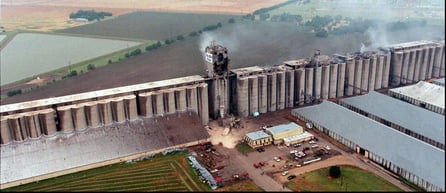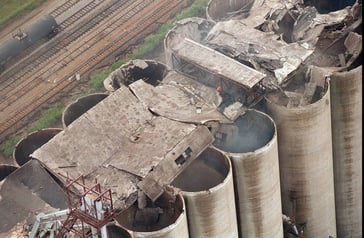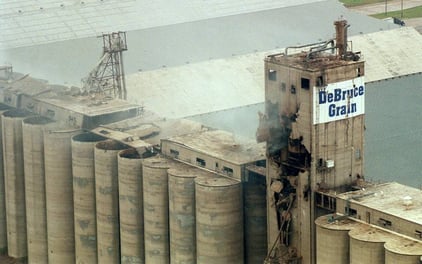 In 1998 the Guinness Book of World Records reported the DeBruce Grain elevator as the largest grain elevator in the entire world. However, this doesn’t mean it was the safest, and on June 8, 1998 a grain dust explosion occurred at the facility, killing 7 people and injuring many more. Now, 17 years later the company and rescue personnel are much more prepared and aware of the dangers.
In 1998 the Guinness Book of World Records reported the DeBruce Grain elevator as the largest grain elevator in the entire world. However, this doesn’t mean it was the safest, and on June 8, 1998 a grain dust explosion occurred at the facility, killing 7 people and injuring many more. Now, 17 years later the company and rescue personnel are much more prepared and aware of the dangers.
About the Explosion
At the time of the grain dust explosion the DeBruce grain elevator consisted of 310 grain storage silos and had a 20.7 million bushel capacity, but was only storing 7 million bushels of wheat and sorghum. These silos were in a line three wide, with a headhouse in the middle The suspected cause of the explosion was discovered by OSHA inspectors to be a bad ball bearing in a seized grain belt motor, which caused a spark and ignited the grain dust.
 The initial explosion took place on the southern side of the line of silos, but a series of secondary explosions moved throughout crossover tunnels going in both directions. These explosions not only moved horizontally through the crossover tunnels, but vertically through the actually silos, blowing the roofs off many of them.
The initial explosion took place on the southern side of the line of silos, but a series of secondary explosions moved throughout crossover tunnels going in both directions. These explosions not only moved horizontally through the crossover tunnels, but vertically through the actually silos, blowing the roofs off many of them.
In most grain elevator explosions the use of blast gates helps to lower the force of the explosions, and causes the concrete structure to just break up. In this instance the blast gates were either blown away or disabled by the force of the explosion, which caused the concrete structures to be pulverized by the blast.
 The explosion could be heard over 10 miles away, and it took a task force of 62 people working in 12 hour shifts for 5 days to look for the missing workers. In the week before the fatal explosion there had been a fire caused by a hot bearing in the same area where the explosion began. This fire was extinguished by employees, but no measures were taken to fix the bearings.
The explosion could be heard over 10 miles away, and it took a task force of 62 people working in 12 hour shifts for 5 days to look for the missing workers. In the week before the fatal explosion there had been a fire caused by a hot bearing in the same area where the explosion began. This fire was extinguished by employees, but no measures were taken to fix the bearings.
Modern Improvements
The Sedgwick County Division Chief Carl Cox said that when they were searching for survivors they used only the limited supplies they had on hand. This included sheets of plywood, 4 x 4 wood posts, and basic jacks. He explained that now they have much more sophisticated equipment and that, “I would say our response capabilities was then probably a 2 and today we’re a 10”.
These first responders now have have cameras able to be placed in small areas, and microphones that are so sensitive they can hear a bottle cap being dropped eight feet away. OSHA’s area inspector says that now businesses are inspected for combustible dust issues, and companies are working to address these issues and remove hazards.

